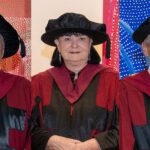C185/10
Entomology experts will gather this week at the 41st Australian Entomological Society (AES) scientific conference to discuss the importance of insect-related research to the Australian economy and the environment.
Curtin University is a Silver Sponsor of the upcoming conference that is being held from 26-30 September 2010 at The Vines Resort in Perth and has 160 delegates from Australia and overseas.
This year’s conference theme is ‘Entomology: For Australia’s Future’.
“This theme highlights the importance of entomology and the continued need for entomologists now and into the future,” said member of the organising committee Professor Jonathan Majer, Professor of Invertebrate Conservation in the Department of Environment and Agriculture at Curtin University.
“One introduced pest species could cost the Australian economy tens of millions of dollars per year,” Professor Majer said.
“The economic impact of insects is measured not only by the market value of products they destroy and the cost of damage they inflict but also by the money and resources expended on prevention and control of pest outbreaks.
“Although dollar values for these losses are nearly impossible to calculate, especially when they affect human health and welfare, economists generally agree that insects consume or destroy around 10 per cent of gross national product in large, industrialized nations and up to 25 per cent of gross national product in some developing countries.”
Leading experts in the field will be present to give keynote lectures around the themes. WA Chief Scientist Professor Lyn Beazley will open the conference.
Plenary speaker, Dr Shashi Sharma from the WA Department of Agriculture and Food (DAFWA), will speak about Biosecurity in Western Australia, which remains one of the most pest and disease free agricultural production areas in the world.
Keynote speakers include Professor Joseph Allotey from Botswana, who will be speaking about ‘Challenges Imposed by Climate Change and Future Outlook’. Dr Lazaro Roque-Albelo formerly from the Galapagos Islands Charles Darwin Research Station, will speak about ‘“Dangerous travellers”, Introduction and Dispersion of insect species by tourism boats in the Galapagos Islands, Ecuador’. Professor Raphael Didham from the University of Western Australia will speak about ‘Invertebrate diversity and conservation: global threats, local challenges’. Dr Mark Harvey from the WA Museum will talk about ‘Systematic research in the 21st century – what can be delivered and how?’
As part of the National Invertebrate Pest Initiative (NIPI) project, an “ISpy” pest identification training manual has been developed and will be launched at morning tea on 29 September. ISpy will only be available to workshop participants and will not be sold otherwise.
AES is the only organisation representing professional entomologists of Australia.
“The society aims to advance and disseminate entomological knowledge in all its aspects, particularly but not exclusively, in relation to the Australian fauna,” Professor Majer said.
The society began in 1965 and has been holding annual conferences since 1967 and hosted the International Congresses of Entomology in 1972 and 2004. Membership boasts six fellows of the Australian Academy of Science. The society produces a journal, the Australian Journal of Entomology, the Myrmecia newsletter, provide research grants and make a number of student and professional awards each year.
Editors/COS:
The conference logo is the Western False Saturn Moth or Dryandra Moth Carthaeidae, Carthaea saturnioides. Feeding on Grevillea and Banksia species, the moth’s activity season is August to December, so there is currently the chance to see it in its native range. An image of the moth is available upon request.
The Society’s logo features the red bull ant Myrmecia gulosa (Fabricius, 1775) which was one of the first Australian insects to be formally named. The first specimen was collected in “New Holland” by Joseph Banks in 1770 and this specimen is still in good condition in the Joseph Banks Collection held in the Natural History Museum, London. The species is known as the giant bull dog ant (body length up to 30 mm) and is common in eastern Australia. It has very large jaws and a powerful venom and is one of the most distinctive and striking elements of our entomological fauna. An image of the red bull ant is available on request.
More information can be found on the conference website at http://aes2010.org/ or on the Society’s website: http://www.austentsoc.org.au/
Contacts:
Professor Jonathan D. Majer, Professor of Invertebrate Conservation| Department of Environment and Agriculture, School of Science, Faculty of Science and Engineering, Curtin
Tel: 08 9266 7964, Mobile: 0401 103 017, Email: J.Majer@curtin.edu.au
Teresa Belcher, Public Relations, Curtin
Tel: 08 9266 9085, Mobile: 0401 103 755, Email: teresa.belcher@curtin.edu.au


